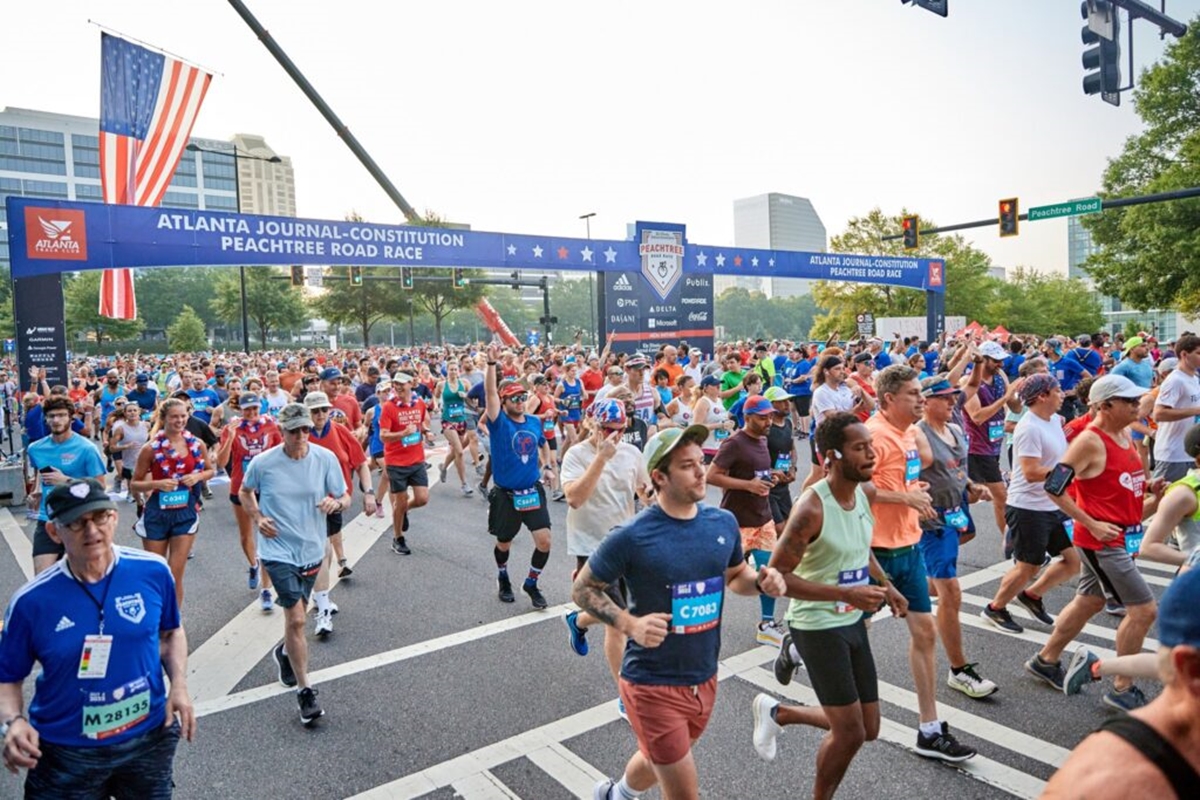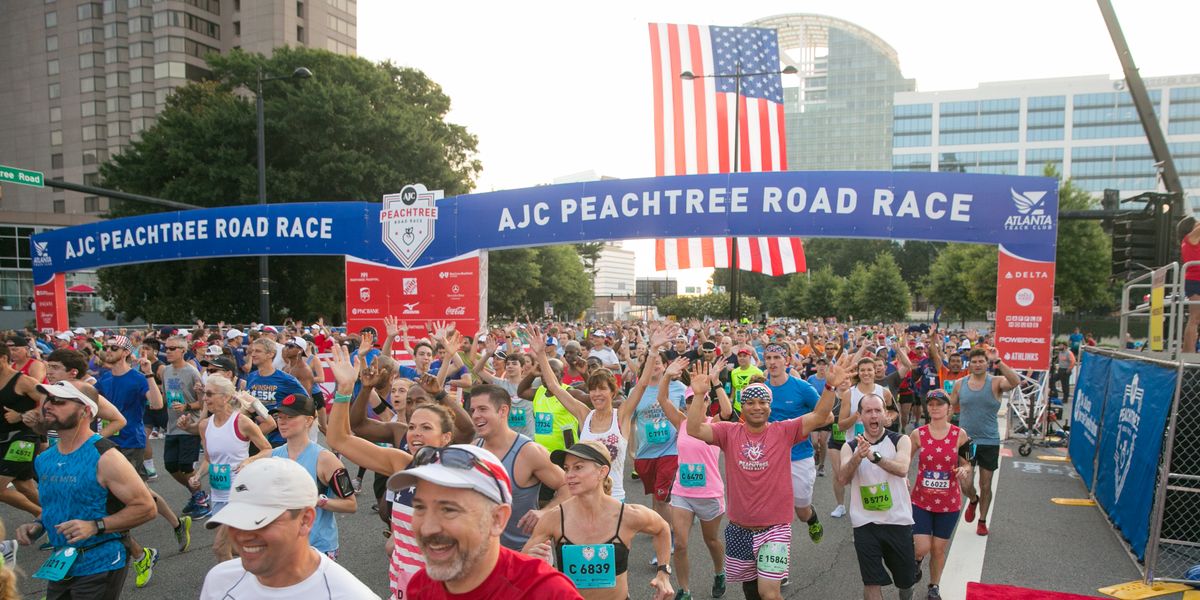

Featured
What Exercise Can Replace 10K Run
Modified: August 21, 2023
Discover a featured exercise that can replace your 10K run. Enhance your fitness routine and achieve the same benefits with this alternative workout.
Introduction
Running is a popular form of exercise that offers numerous physical and mental benefits. Whether you enjoy hitting the pavement in the early morning or participating in organized races, running can be a great way to stay fit and improve cardiovascular health. However, for some individuals, completing a 10K run may not be feasible due to various reasons such as physical limitations, time constraints, or simply a lack of interest in long-distance running.
The good news is that there are plenty of alternative exercises that can provide similar benefits to a 10K run and cater to different fitness levels and preferences. By incorporating these exercises into your routine, you can still achieve a challenging and effective workout without having to lace up your running shoes.
Before exploring these alternatives, it’s important to recognize the benefits that running offers. Running helps to strengthen muscles, improve endurance, burn calories, and boost mental well-being. It also increases bone density, reduces the risk of heart disease, and enhances cognitive function. Running can be a wonderful way to clear your mind, relieve stress, and enjoy the outdoors.
However, running does have its limitations. It puts repetitive stress on the joints, particularly the knees, which can lead to overuse injuries. The high-impact nature of running also makes it unsuitable for individuals with certain conditions, such as arthritis or joint pain. Additionally, excessive running without proper rest and recovery can increase the risk of fatigue and burnout.
So, if you’re looking for alternatives to a 10K run, don’t worry! There are plenty of exercises that can provide a similar level of challenge and engagement. In the following sections, we will explore a variety of alternative exercises that can help you achieve your fitness goals while minimizing the impact on your joints and providing a fun and effective workout.
Benefits of Running
Running offers a wide range of physical and mental benefits that make it a popular form of exercise. Here are some of the key advantages of incorporating running into your fitness routine:
- Cardiovascular Health: Running is an excellent cardiovascular exercise that increases heart rate, strengthens the heart muscles, and improves overall cardiovascular health. Regular running can lower the risk of heart disease, high blood pressure, and stroke.
- Weight Management: Running is a calorie-burning activity that can help in maintaining a healthy weight or losing excess pounds. It is an effective way to burn calories and boost metabolism.
- Muscle Strength and Endurance: Running engages multiple muscle groups, including the legs, core, and upper body. It helps to strengthen and tone these muscles, improving overall strength and endurance.
- Bone Health: Running is a weight-bearing exercise that stimulates bone growth and improves bone density. It can help in preventing conditions such as osteoporosis and reduces the risk of fractures.
- Mental Well-being: Running releases endorphins, also known as “feel-good” hormones, which can boost mood, reduce stress, and alleviate symptoms of anxiety and depression. It can also improve cognitive function and enhance focus and concentration.
- Improved Sleep: Regular running promotes better sleep quality, helping you to fall asleep faster and enjoy a deeper and more restorative sleep.
- Increased Energy Levels: Running increases energy levels by improving blood circulation and oxygen flow throughout the body. It can provide a natural energy boost and help combat fatigue.
- Longevity: Studies have shown that regular running is associated with a longer lifespan. It can contribute to overall longevity and reduce the risk of premature death.
These are just a few of the many benefits that running offers. However, it’s important to keep in mind that running may not be suitable for everyone. Individuals with specific health concerns or physical limitations should consult with a healthcare professional before starting a running program.
Limitations of Running
While running has numerous benefits, it also has its limitations and may not be the ideal exercise for everyone. Here are some of the limitations of running to consider:
- Joint Impact: Running is a high-impact sport that puts stress on the joints, particularly the knees and ankles. This can lead to overuse injuries such as shin splints, knee pain, and stress fractures.
- Overuse Injuries: Running involves repetitive motions that can lead to overuse injuries if proper rest and recovery are not incorporated into a training regimen. Common overuse injuries include tendinitis, IT band syndrome, and plantar fasciitis.
- Physical Limitations: Some individuals may have physical limitations that make running difficult or unsafe. Conditions such as arthritis, joint pain, or previous injuries may require lower-impact exercises.
- Time Commitment: Running long distances, such as a 10K, requires a significant time commitment for training. Some individuals may not have the time or flexibility in their schedule to dedicate to long-distance running.
- Boredom or Lack of Interest: Not everyone finds running enjoyable or engaging. It can become monotonous over time, leading to boredom or a lack of motivation to continue with a running routine.
- Weather Limitations: Running outdoors is dependent on weather conditions. Extreme temperatures, inclement weather, or poor air quality can limit the ability to run outside safely and comfortably.
- Recovery Time: Running places a significant demand on the body, requiring adequate time for recovery and muscle repair. Without proper recovery, there is an increased risk of fatigue, burnout, or decreased performance.
It’s important to listen to your body and take these limitations into consideration. If you experience pain or discomfort while running, it may be necessary to explore alternative exercises that are more suitable for your specific needs and goals.
Alternative Exercises to Replace a 10K Run
If you’re looking for alternatives to a 10K run, there are plenty of exercises that can provide a similar level of challenge and engagement. Here are some excellent options to consider:
- Cycling: Cycling is a low-impact exercise that provides a great cardiovascular workout. Whether you prefer outdoor cycling or a stationary bike at the gym, cycling can improve leg strength, burn calories, and offer a scenic and enjoyable workout experience.
- Swimming: Swimming is a full-body workout that is gentle on the joints. It improves cardiovascular fitness, builds strength and endurance, and engages multiple muscle groups simultaneously. Swimming is an excellent option for those with joint pain or injuries.
- High-Intensity Interval Training (HIIT): HIIT workouts involve short bursts of intense exercise followed by periods of rest. These workouts can be done with various exercises such as jumping jacks, burpees, or mountain climbers. HIIT is a time-efficient way to burn calories, improve cardiovascular fitness, and boost metabolism.
- Rowing: Rowing is a full-body workout that engages muscles in the arms, legs, and core. It provides a low-impact cardio workout while improving strength, endurance, and posture. Rowing machines are available in most gyms and can be a great alternative to running.
- Stair Climbing: Climbing stairs is an effective way to elevate your heart rate and engage the lower body muscles. Whether it’s using a stair climber machine or finding a set of stairs to climb, this exercise can help build leg strength, improve cardiovascular fitness, and burn calories.
- Elliptical Machine: The elliptical machine provides a low-impact alternative to running while still offering a challenging cardiovascular workout. It engages multiple muscle groups, improves endurance, and allows for varying levels of resistance and intensity.
- Jumping Rope: Jumping rope is a simple yet effective exercise that can be done anywhere. It improves cardiovascular fitness, coordination, and agility. Jumping rope is a high-impact exercise, so it’s important to use proper technique and gradually increase intensity.
- Circuit Training: Circuit training involves performing a series of exercises targeting different muscle groups with minimal rest in between. This type of workout provides both cardiovascular and strength benefits. It can be customized to individual fitness levels and preferences.
- Dancing or Zumba: Dancing or joining a Zumba class is a fun and energetic way to get your heart rate up and improve cardiovascular fitness. It combines dance moves with aerobic exercises, making it an enjoyable alternative to traditional running workouts.
These alternative exercises offer a variety of options to keep your workout routine interesting and effective. Remember to choose exercises that align with your fitness goals, preferences, and any existing physical limitations. Don’t be afraid to mix and match different activities to create a well-rounded and enjoyable fitness regimen.
Cycling
Cycling is a fantastic alternative to a 10K run that provides a challenging and enjoyable cardiovascular workout. Whether you prefer outdoor cycling or riding a stationary bike at the gym, cycling offers a range of benefits for your physical health and well-being.
One of the biggest advantages of cycling is that it is a low-impact exercise, meaning it puts less stress on your joints compared to running. This makes it an excellent choice for individuals with joint pain or those who want to minimize the risk of injury. Cycling targets the muscles in your legs, including the quadriceps, hamstrings, and calves, helping to strengthen and tone them.
In addition to its physical benefits, cycling also offers mental and emotional advantages. It is a great way to explore the outdoors, enjoy nature, and escape the confines of a gym. Cycling can be a social activity as well, allowing you to ride with friends or join cycling groups in your community.
To get the most out of your cycling workouts, consider incorporating different types of rides into your routine. You can try interval training, where you alternate between periods of high-intensity cycling and recovery periods of lower intensity. This helps to improve your cardiovascular fitness and burn more calories. You can also challenge yourself with hill climbs to increase the intensity and engage your leg muscles even more.
If outdoor cycling is not practical or accessible to you, indoor cycling on a stationary bike is a great alternative. Many gyms offer cycling classes led by instructors who guide you through various workout routines, providing motivation and a sense of camaraderie. The resistance levels on stationary bikes can be adjusted to match your fitness level and allow for progressive overload.
Remember to always prioritize safety while cycling. Wear a properly fitted helmet, follow traffic rules and signals, and use appropriate cycling gear for comfort and visibility. If you’re new to cycling, start with shorter rides and gradually increase your distance and intensity as your fitness improves.
Overall, cycling is an excellent alternative exercise to replace a 10K run. It offers a low-impact workout that targets your leg muscles, improves cardiovascular health, and provides an enjoyable and versatile fitness experience. So, hop on a bike and start pedaling your way to better health and fitness!
Swimming
Swimming is a highly recommended alternative to a 10K run, offering a low-impact, full-body workout that is gentle on the joints. Whether you prefer to swim in a pool or in open water, swimming offers numerous benefits for both physical fitness and overall well-being.
One of the key advantages of swimming is that it engages multiple muscle groups, providing a comprehensive workout for your entire body. From your arms, shoulders, and back to your core and lower body, the resistance of the water helps to strengthen and tone muscles effectively.
Swimming is a non-weight-bearing exercise, meaning it puts minimal stress on the joints. This makes it an ideal choice for individuals with joint pain, arthritis, or those recovering from injuries. Unlike running, where the impact can strain the knees or ankles, swimming provides a cushioning effect that protects the joints while still providing a challenging workout.
In addition to its physical benefits, swimming is also known for its cardiovascular advantages. The continuous swimming motion increases heart rate and improves cardiovascular fitness. It can help lower blood pressure, reduce the risk of heart disease, and improve lung capacity.
Swimming is also a great way to improve flexibility and range of motion. The water provides resistance in all directions, allowing your muscles to stretch and move in ways that may be more challenging on land. This can lead to improved joint mobility and overall flexibility.
Furthermore, swimming offers a refreshing and calming experience that can have positive effects on mental well-being. The rhythmic motion of swimming, combined with the soothing sensation of being in the water, can help reduce stress and promote relaxation. It provides a break from the hustle and bustle of daily life and offers a meditative environment to clear your mind.
If you’re new to swimming or looking to improve your technique, consider taking swim lessons or joining a swim club. Having proper guidance and instruction can help you develop efficient swimming strokes, improve your technique, and make the most out of your swim workouts.
Whether you’re swimming laps in a pool or enjoying a dip in the ocean, swimming is an excellent alternative exercise to replace a 10K run. It provides a full-body workout, improves cardiovascular health, and offers a refreshing and rejuvenating experience. So, grab your swimwear, dive into the water, and make a splash towards a fitter and healthier you!
High-Intensity Interval Training (HIIT)
High-Intensity Interval Training (HIIT) is a popular alternative to a 10K run that provides a challenging, time-efficient, and effective workout. HIIT involves short bursts of intense exercise followed by short periods of rest or lower-intensity activity. This type of training can be done in various forms and offers numerous benefits for cardiovascular fitness and overall body conditioning.
One of the key advantages of HIIT is its ability to burn a significant amount of calories in a shorter period of time. The intense bursts of activity elevate your heart rate and ramp up your metabolism, resulting in increased calorie burning during and after exercise. This makes HIIT a time-efficient option for those with busy schedules or limited time to dedicate to longer workouts.
HIIT workouts can be customized to individual fitness levels and can be adapted to various exercises, such as running, cycling, bodyweight exercises, or any other form of cardiovascular activity. The intensity and duration of work and rest intervals can be adjusted to match your fitness level and goals.
In addition to its calorie-burning benefits, HIIT also improves cardiovascular fitness and endurance. The short, intense bursts of exercise push your heart rate to higher levels, challenging your cardiovascular system and improving its capacity to deliver oxygenated blood to your muscles. Over time, this can lead to improvements in overall cardiovascular health.
Another advantage of HIIT is its ability to promote muscle growth and strengthen your body. The intense nature of HIIT workouts stimulates the release of growth hormones, which can help build lean muscle mass. It also improves muscular endurance by forcing your muscles to work harder and adapt to the demands of the high-intensity intervals.
One of the great things about HIIT is its versatility and flexibility. You can customize your HIIT routine to fit your preferences and equipment available. Whether you prefer to perform bodyweight exercises at home, use cardio machines at the gym, or engage in outdoor activities, there are endless possibilities for creating challenging and effective HIIT workouts.
Keep in mind that HIIT workouts are intense, so it’s important to approach them with proper technique and gradually increase the intensity over time. Additionally, it’s crucial to listen to your body and allow for adequate recovery between HIIT sessions to prevent overtraining and minimize the risk of injury.
Overall, HIIT is an excellent alternative to a 10K run, providing a time-efficient and effective workout that can improve cardiovascular fitness, burn calories, and promote muscle growth. Incorporating HIIT into your exercise routine can add variety, challenge, and excitement to your workouts, helping you achieve your fitness goals in a shorter amount of time.
Rowing
Rowing is a highly effective alternative exercise to replace a 10K run, offering a full-body workout that engages various muscle groups and provides cardiovascular benefits. Whether you row on a watercraft in open water or use a rowing machine at the gym, rowing offers a low-impact yet challenging workout that can help improve strength, endurance, and overall fitness.
One of the key advantages of rowing is that it engages multiple muscle groups simultaneously. The rowing motion works the muscles in your legs, glutes, core, arms, and back, providing a comprehensive workout. This makes rowing an excellent choice for those looking to build strength and tone their muscles.
Rowing is a low-impact exercise, making it ideal for individuals with joint pain or those who want to minimize stress on their joints. The smooth gliding motion on the rowing machine or paddling in the water provides resistance without the impact associated with running. This makes rowing a suitable option for individuals with conditions such as arthritis or previous joint injuries.
In addition to its muscular benefits, rowing is known for its cardiovascular advantages. It is an effective aerobic exercise that increases your heart rate and improves cardiovascular fitness. Rowing can enhance lung capacity and improve oxygen uptake, leading to better overall endurance and stamina.
Rowing is a highly versatile exercise that can be adapted to different fitness levels and goals. Whether you want to focus on endurance, strength, or interval training, rowing allows you to adjust the resistance and intensity to match your preferences and needs. By monitoring your stroke rate and time, you can challenge yourself and track your progress over time.
Another advantage of rowing is that it provides a low-impact workout while still offering a sense of accomplishment and intensity. Rowing can be both challenging and rewarding, pushing you to improve your technique, speed, and power with each stroke.
If you have access to open water, rowing in a boat can provide the added benefits of fresh air, nature, and the serenity of being on the water. Rowing clubs or organizations often offer opportunities for beginners to learn and explore the sport.
For those who prefer the convenience and accessibility of a gym, rowing machines are widely available. These machines simulate the rowing motion and offer various settings to adjust resistance and monitor your performance.
Regardless of whether you row on the water or use a rowing machine, it’s important to maintain proper form and technique to maximize the benefits and prevent injury. Seek guidance from a qualified instructor or trainer to ensure you are using the correct posture, grip, and stroke technique.
Incorporating rowing into your fitness routine can provide a refreshing change of pace from running while offering a challenging and effective full-body workout. So, grab an oar or hop on a rowing machine to experience the benefits of this alternative exercise.
Stair Climbing
Stair climbing is a highly effective alternative exercise to replace a 10K run. It offers a challenging cardiovascular workout that targets your lower body muscles and helps improve endurance and strength. Whether you climb stairs in a building, use a stair climber machine at the gym, or find hills or stairs outdoors, stair climbing can provide a rewarding and invigorating exercise experience.
One of the key advantages of stair climbing is its ability to engage multiple muscle groups in your lower body. The repetitive motion of climbing stairs targets your quadriceps, hamstrings, glutes, and calves, helping to tone and strengthen these muscles. It is also a weight-bearing exercise, which can contribute to improved bone density and overall bone health.
Stair climbing is a high-intensity aerobic exercise that elevates your heart rate, improving cardiovascular fitness and endurance. The vertical ascent of the stairs requires greater effort and recruits more muscles compared to running on flat ground. This translates to a higher calorie burn and increased cardiovascular benefits.
Another benefit of stair climbing is its versatility and accessibility. Whether you have access to a tall building, a stair climber machine, or a hill in your neighborhood, you can incorporate stair climbing into your routine. This makes it a convenient option that can be done virtually anywhere.
In addition to its physical benefits, stair climbing also provides a mental boost. The act of conquering a set of stairs, especially when faced with a challenging climb, can instill a sense of accomplishment and motivation. This can have a positive impact on your overall well-being and mental resilience.
If you’re looking to make your stair climbing workouts more challenging, consider incorporating interval training. Alternate between climbing stairs at a moderate pace and sprinting up the stairs at a faster pace. This helps to increase intensity, burn more calories, and improve cardiovascular fitness. You can also try incorporating variations such as skipping steps or taking two steps at a time to add a different dimension to your workout.
It’s important to practice proper technique when engaging in stair climbing to avoid straining or injuring your muscles. Ensure you maintain good posture, use the handrail if necessary for balance, and step with control to prevent slips or falls.
Whether you’re climbing stairs in a skyscraper, using a stair climber machine, or conquering hills in your neighborhood, stair climbing provides a challenging and effective alternative to a 10K run. It targets multiple muscle groups, improves cardiovascular fitness, and offers a workout that can be tailored to your fitness level and preferences. So, embrace the stairs, elevate your fitness, and step closer to your health and wellness goals.
Elliptical Machine
The elliptical machine is a popular alternative exercise to replace a 10K run, providing a low-impact yet challenging cardiovascular workout. Whether you use an elliptical machine at the gym or have one at home, this versatile piece of equipment can help improve cardiovascular fitness, burn calories, and strengthen your muscles.
One of the major advantages of using an elliptical machine is its low-impact nature. The elliptical motion mimics the natural movement of walking or running, but without the repeated impact on your joints. This makes it an excellent choice for individuals with joint pain or those who want to minimize the risk of injury.
An elliptical machine engages both the upper and lower body muscles, making it a full-body workout. The pushing and pulling motion of the handles engages the muscles in your arms, shoulders, and back, while the pedaling motion targets the muscles in your legs, including your calves, quadriceps, and hamstrings. This helps to improve muscle strength and tone throughout your body.
Elliptical machines also offer the benefit of versatility and adjustability. You can adjust the resistance levels to increase or decrease the challenge of your workout, making it suitable for individuals of different fitness levels. Many machines also come with built-in programs that allow you to vary your workout intensity or simulate different terrains.
In addition to its physical benefits, the elliptical machine allows for a controlled and continuous motion, reducing the risk of sudden impact and jarring movements. This can be beneficial for individuals recovering from injuries or those who require a low-impact exercise option.
Using an elliptical machine is a great way to improve cardiovascular fitness. The continuous motion elevates your heart rate, working your heart and lungs. This can lead to increased endurance, improved lung capacity, and better overall cardiovascular health.
One advantage of exercising on an elliptical machine is that it can be a less monotonous option compared to running. Many machines include built-in features like music compatibility, TV screens, and virtual workouts that can keep you motivated and engaged during your workout sessions.
Remember to maintain proper form while using an elliptical machine. Keep your posture upright, engage your core muscles, and use the handles as needed for balance and support. Start with a comfortable resistance level and gradually increase it as you become more comfortable and stronger.
Whether you’re looking to burn calories, improve cardiovascular fitness, or strengthen your muscles, the elliptical machine offers a low-impact and effective alternative to a 10K run. So, hop on the machine, embrace the smooth and fluid motion, and enjoy a rewarding workout experience.
Jumping Rope
Jumping rope is a simple yet highly effective alternative exercise to replace a 10K run. It offers a fun and challenging cardiovascular workout that can be done virtually anywhere, making it a convenient option for those with limited space or access to equipment. Jumping rope not only improves cardiovascular fitness but also helps to build agility, coordination, and muscular endurance.
One of the major benefits of jumping rope is its ability to elevate your heart rate quickly, making it an excellent aerobic exercise. The constant jumping and landing engage large muscle groups, challenging your cardiovascular system and helping to improve endurance over time. Regular jumping rope can enhance your lung capacity, increase stamina, and boost overall cardiovascular health.
Jumping rope also offers the advantage of being a high-intensity, calorie-burning exercise. It can help you burn a significant number of calories in a short amount of time, making it an efficient option for those looking to shed body fat or maintain a healthy weight. Additionally, jumping rope engages muscles in your arms, shoulders, core, and legs, providing a full-body workout that helps to tone and strengthen these areas.
One of the appeals of jumping rope is its versatility and adaptability. As you become more comfortable with the basic jump, you can challenge yourself by incorporating different variations such as running in place, high knees, or double unders (spinning the rope twice under your feet with each jump). You can also vary the speed and duration of your jumping sessions to add variety and intensity to your workouts.
Jumping rope is a highly portable exercise that requires minimal space and equipment. All you need is a sturdy jump rope and enough room to swing it around. This makes it a convenient option for home workouts, outdoor workouts, or even while traveling.
It’s important to ensure proper technique and form while jumping rope to minimize the risk of injury and maximize the benefits. Start with a rope length that is appropriate for your height, keeping your elbows close to your sides and your wrists relaxed. Jump with a slight bounce, landing softly on the balls of your feet, and maintain a straight posture with engaged core muscles.
As with any exercise, it’s important to gradually increase the intensity and duration of your jumping rope sessions. Start with shorter intervals and gradually work your way up to longer durations as your fitness improves. It’s also essential to listen to your body and rest when needed to avoid overuse injuries.
So, grab a jump rope and get ready to elevate your heart rate, burn calories, and improve your agility and coordination with this fun and effective alternative to a 10K run. Jumping rope is an excellent way to add variety and intensity to your workouts while reaping numerous physical and cardiovascular benefits.
Circuit Training
Circuit training is a dynamic and versatile alternative exercise to replace a 10K run. It combines cardiovascular exercise with strength training to provide a comprehensive and time-efficient workout. Circuit training involves moving through a series of exercises, targeting different muscle groups, with minimal rest in between. This type of training offers numerous benefits, including improved cardiovascular fitness, increased strength, and enhanced muscular endurance.
One of the key advantages of circuit training is its ability to provide both aerobic and anaerobic benefits. The combination of cardiovascular exercises, such as jumping jacks or high knees, with strength exercises, like squats or push-ups, elevates your heart rate while challenging your muscles. This results in improved cardiovascular fitness and increased calorie burn.
Circuit training is highly customizable, allowing you to tailor your workout to your fitness level and goals. You can choose exercises that target specific muscle groups or opt for full-body exercises for a well-rounded workout. You can also adjust the intensity by modifying the number of repetitions, the duration of each exercise, or the amount of resistance used.
Another advantage of circuit training is its ability to keep your workouts fresh and engaging. The variety of exercises in a circuit helps to prevent boredom and monotony. This can be especially beneficial for individuals who find long-distance running repetitive or those who thrive on variety and constant change in their workouts.
Circuit training also promotes muscle strength and endurance. By engaging in resistance exercises, such as weightlifting or bodyweight exercises, you can build strength in various muscle groups. The continuous movement from one exercise to the next helps to improve muscular endurance, allowing your muscles to work harder for longer periods.
Not only does circuit training offer physical benefits, but it also provides mental stimulation. The combination of different exercises and the fast-paced nature of circuit training can challenge your mental focus and improve cognitive function. This can result in enhanced coordination, reaction time, and overall mental alertness.
You can design your own circuit training routine or follow pre-designed circuit workouts available online or through fitness apps. Incorporate a mix of cardiovascular exercises, such as jumping jacks, burpees, or mountain climbers, along with strength exercises like squats, lunges, push-ups, or dumbbell presses. Include a variety of exercises to target different muscle groups and keep your body challenged.
Remember to start with a proper warm-up to prep your body for the workout and cool down afterward to allow for proper recovery. It’s also important to listen to your body and take rest breaks as needed during your circuit training sessions to prevent overexertion and reduce the risk of injury.
Incorporating circuit training into your fitness routine provides a refreshing alternative to a 10K run. The combination of cardiovascular and strength exercises offers a challenging and efficient workout that helps improve overall fitness, increases strength, and boosts endurance. So, get ready to switch up your workout routine and experience the many benefits of circuit training.
Dancing or Zumba
If you’re looking for a fun and energetic alternative exercise to replace a 10K run, dancing or participating in a Zumba class can be a fantastic choice. Dancing and Zumba offer a lively and engaging way to get your heart rate up, burn calories, and improve overall fitness while enjoying the rhythm and music.
One of the major advantages of dancing or participating in a Zumba class is the enjoyment factor. Dancing allows you to express yourself and let loose while moving to the beat of the music. Zumba, in particular, combines dance moves with aerobic exercises, creating a high-energy workout experience that feels more like a dance party than traditional exercise. The upbeat music, energetic instructors, and group atmosphere can make the workout feel more like fun than work.
Besides the enjoyment factor, dancing and Zumba provide numerous physical benefits. The repetitive movements and full-body engagement in dancing help improve cardiovascular health by increasing heart rate and endurance. The dynamic nature of dance and Zumba routines involves different muscle groups, leading to improved strength, flexibility, and coordination.
Dancing and Zumba can also help enhance balance and agility as you learn and execute various dance steps, turns, and jumps. These movements require control and coordination, improving stability and body awareness.
Another advantage of dancing or participating in Zumba is its versatility. There are various dance styles and variations, from Latin dance-inspired Zumba to hip-hop, salsa, or even Bollywood dance classes. This variety allows you to explore different styles and find one that suits your preferences and interests.
Regardless of your skill level, dancing and Zumba classes are typically designed to be inclusive and cater to participants of all backgrounds and fitness levels. Instructors provide modifications and options for different intensity levels, allowing you to adapt the workout according to your comfort level.
You can find dance classes or Zumba sessions in fitness studios, community centers, or even virtual platforms. If you prefer to dance at home, you can follow online dance tutorials or dance along with workout videos specifically designed for dance fitness.
Remember to warm up before engaging in dance or Zumba workouts to prepare your body for the movements. Stretching your muscles and practicing proper form can help prevent injuries and enhance your overall performance. Stay hydrated throughout the workout and take breaks as needed to rest and recover.
So, put on your dancing shoes, let the music move you, and experience the joy and benefits of dancing or participating in a Zumba class. These lively and dynamic workouts offer a refreshing alternative to a 10K run while boosting cardiovascular health, enhancing coordination, and leaving you with a smile on your face.
Conclusion
When it comes to finding an alternative exercise to replace a 10K run, it’s important to consider your fitness goals, preferences, and any physical limitations you may have. Fortunately, there are numerous options available that can provide a similar level of challenge and engagement, while offering a variety of benefits for your overall fitness and well-being.
Cycling, swimming, high-intensity interval training (HIIT), rowing, stair climbing, elliptical machine workouts, jumping rope, circuit training, and dancing/Zumba are all excellent alternatives to consider. Each of these exercises offers unique advantages, allowing you to target different muscle groups, improve cardiovascular fitness, and enjoy a diverse range of workout experiences.
It’s important to choose an alternative exercise that aligns with your fitness level, goals, and interests. Consider factors such as impact on joints, versatility, accessibility, and mental engagement. Additionally, consult with a healthcare professional if you have any specific health concerns or limitations before starting a new exercise program.
By incorporating alternative exercises into your fitness routine, you can stay motivated, prevent workout plateaus, and continue reaping the physical and mental benefits of exercise. Remember to listen to your body, practice proper form, and gradually increase the intensity and duration of your workouts.
Ultimately, the goal is to find an enjoyable and sustainable exercise routine that keeps you motivated and excited to stay active. So, explore these alternative exercises, try new activities, and discover the ones that bring you joy and help you achieve your fitness goals. Embrace the journey, and here’s to a healthy, active, and fulfilling lifestyle!








